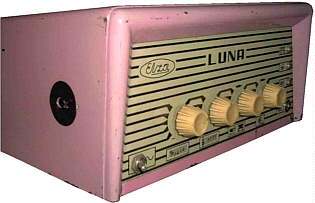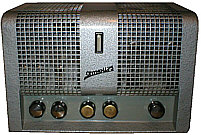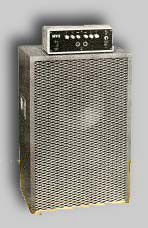Home
WAVAC MD-300B
- Details
- Category: Photo gallery
- Hits: 25725

Grzegorz "gsmok" Makarewicz
Very interesting and exclusive design. I must admit that until the amplifier hit in my arms I do not even realize that any copy of it is located in Poland. And suddenly such a pleasant surprise. I invite you to analyze the photographs showing construction details.
Tube Amplifier Yaqin MC-100B
- Details
- Category: Photo gallery
- Hits: 25360

Grzegorz "gsmok" Makarewicz,
Yaqin MC-100B is a Chinese stereo tube amplifier. It's original name, which is a registered trademark, has some strange symbols and you can not write it using "traditional" alphabet. Willy-nilly, in this relation I am forced to use the Yaquin name. This approach is justified because even in the manual, strange symbol appears on the cover, but in the inside you can find the name Yaqin MC-100B. The amplifier does not has sophisticated look. The distinctive frame constituting the tubes cover reminds me of a container for storing bread  and willingly I would use this amp with a frame permanently dismantled and hidden in some inaccessible place
and willingly I would use this amp with a frame permanently dismantled and hidden in some inaccessible place .
.
Tube amplifier WS17 LUNA
- Details
- Category: Photo gallery
- Hits: 18834

Description and photos of details by Andrzej Żółtowski, photos by Piotr Stanisz Łódź.
[page was updated on April 3, 2005.]
At the end of the first half of the sixties a small audio amplifier appeared in small electronics stores. It had an avant-garde for those times appearance and shocking pink colored casing.
This was, produced by Warsaw manufacturer called "ELZA", the "WS17 Luna" amplifier designed for ad-hoc sound reproduction in medium-sized rooms: school auditoriums, smaller churches, small clubs etc.
Tube amplifier WR75-62 "Ampli75"
- Details
- Category: Photo gallery
- Hits: 17173

Photographs of WR75-62 "Ampli75" amplifier ( PZT Warsaw 1964) made and gave to us Mr Piotr Kowalski
The happy owner of an amplifier is Maciej Myga.
Tube amplifier STA25 Renaissance
- Details
- Category: Photo gallery
- Hits: 18177

Grzegorz "gsmok" Makarewicz,
I would like to present some photos of a very interesting STA25 Renaissance tube amplifier manufactured by Woodside Electronics. It's basically a modernized version of the amplifier produced by Radford. The main difference relates to the regulation of quiescent current of output tubes. The amplifier is characterized by interesting and controversial design line. Like previous Radford products, it raises big emotions - from admiration to total criticism.
Tube amplifier PRIBOJ
- Details
- Category: Photo gallery
- Hits: 29465

Grzegorz "gsmok" Makarewicz,
Tube amplifier Priboj (original russian name - Прибой or Breaker in english) is one of the few secondary market tube audio amplifiers manufactured by our neighbors across the eastern border. Like most of devices from that region it has a hopeless design line and poor craftsmanship. The counterweight to these defects is a thoughtful schematic diagram and outstanding sonic performance. In short it is a princess dressed in a beggar's rags.
Tube Amplifier Petrus
- Details
- Category: Photo gallery
- Hits: 18405

Grzegorz "gsmok" Makarewicz,
Tube amplifier "Petrus" is produced by a small manufacture in Ukraine. It is not known to me the number of copies produced - certainly is small - it does not prevent the fact, that at least a few copies of this amplifier operates in the environment of our domestic audiophiles. The amplifier is based on 6S33S tubes (called "devils") operating in class A, and delivering an output power of about 15W per channel.
Tube amplifier MV3
- Details
- Category: Photo gallery
- Hits: 21327

Photographs and description by Zoltan.
(Andrzej Żółtowski,
Mass-produced in the sixties by the East German company VEB Kligenthaller Harmonikawerke (later VERMONA) in Kligenthall, two inputs, microphone - instrumental amplifier MV3, despite the relatively small (12W) output power was extremely successful device in its class.
With the forming of the complete audio system, broadband loudspeaker, MV3 amplifier was the object of sighs and dreams of most chamber music groups, both amateur and professional, from those years because of an exceptionally dynamic and wonderfully "full" sound.
Tube Amplifier "MELOMAN 25"
- Details
- Category: Photo gallery
- Hits: 21534

Grzegorz Makarewicz "gsmok"
Note: 12.02.2012r. added the original diagram of the amplifier
Tube amplifier produced by POLKAT Wroclaw. The design quite controversial when it comes to opinions of holders. Unfortunately, you have to say "let the veil of silence falls on the quality of its assembling". I think, that pictures presented below speak for themselves. I do not mean, of course the damages associated with the normal operation and storage of the amplifier, but the details of construction and the way they are performed by a "qualified" person with blacksmith skills. I think, the best summary of the amplifier can be opinion of Romek (Romekd) presented on TRIODA community:
"Implementation of this amplifier is a complete crap. Photos that have been posted in the Gallery does not provide the full splendor of the primitivism and mediocrity of it's mechanical structure. You simply have to see it with your own eyes, being careful not to hurt yourself during dismantling this technical "miracle". If today, a high school student of electronics want to give any kind of work and it would be done in mechanical terms like this amp, it would not be highly rated. I think that the spiral electric heater is a true masterpiece of grace and elegance when compared to this amp. In addition, electrical design prevents any upgrades and improvements, and the amplifier is characterized by a significant level of hum and noise.
But there is something surprising and magical in this design! First, that after 33 years since the production of this amp it still works, and the measurement of electrolytic capacitors shows their full capacity and overall efficiency (at least in the copy I own). The second is the fact that the properties of the sound of this amp especially when it comes to music reproduction in the low and mid tones (treble tones do not sound quite as good) are pretty decent, not to say that they are very good!
According to several people who listen to this amp, it sounds much better than the modern, recently manufactured home cinema receiver Sony "STR-DB930," which seems almost unbelievable.
It seems even more surprising, given the fact that the design principles of this amplifier are not correct, for example:
- output transformer windings are not divided into sections - hence soprano leaves much to be desired, despite the fact that the core cross section of 17.4 cm2. seems to be large enough for a 25W output power,
- working of the output tubes in pentode mode and applying the typical TV tubes PL500, which will definitely have an impact on the level of harmonic distortion,
- using PCB paths, not a twisted wires to provide filament voltages and thus perhaps 50Hz hum.
Going back to the look of this amp, I think that its appearance had an impact that the amplifiers in those days were not as popular as radio or television sets, which in some cases were a great interior decoration.
However, this amp, despite its primitiveness, inclined me to return to my interests in old devices and tube amps."
So, welcome to the photo gallery. Let's start with a few photographs covering the entire amplifier.
Front view (Fig. 1). The front panel and a wooden enclosure with ventilation holes in the form of narrow slots.

Fig. 1.
Take off the cover (this requires special "rubber", screwdrivers, help of two friends and a bit of sedatives), and here the amplifier interior presents in all its glory (Fig. 2). I must admit that it looks really impressive. Ordered structure. Input preamplifier section protected with the metal grille. Different copies of "MELOMAN" varied in construction details. I would like to quote here Romek's opinion again:
Tube amplifier Audio-Akustyka Auris
- Details
- Category: Photo gallery
- Hits: 17229

Piotr Mason (HAIKU-AUDIO)
Tube amplifier named "Auris" was produced by Audio-Akustyka. According to the specification, it can work as a pentode or triode amplifier, in Push-pull or Single-ended mode, with or without a negative feedback, and in the mysterious "turbo" mode. The manufacturer does not allow peering into the housing due to the use of many "non-standard proprietary solutions". Time to break the seals and keep one's ear to the ground.
Page 7 of 10




